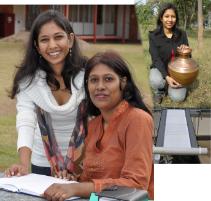Students show their 'metal' to prevent water-borne diseases
Published on 16 July, 2010
India's Riti Sharan and former Bangladesh student Sadia Jihan Khan have crossed paths in Rockhampton, where they have been swapping notes on using metals to kill water-borne diseases.
The PhD researchers share a common supervisor, Professor Rob Reed at CQUniversity, and both presented posters on their projects at the Australian Society of Microbiology Conference in Sydney recently (July 4-8).

Riti (left) and Sadia compare research notes. Insets include Riti with a traditional copper vessel and Sadia's test equipmentPunjab-based Riti is doing laboratory analysis to show how the ancient practice of storing drinking water in copper vessels actually works in killing bacterial diseases, especially cholera, dysentery, typhoid and diarrhoea/gastro-enteritis, as well as viral pathogens.
Riti's work should help community planners encourage use of the most cost-effective and safe copper vessels and water storage procedures throughout areas of Asia, where many people draw their water from natural watercourses.
Sadia, who has come to Australia via a Masters program in New Zealand, is using metal in a different way to harness sunshine as a disinfectant for aquaculture pond systems, such as prawn hatcheries, which provide seafoods for millions across the globe.
Her system involves circulating pond water across a glass plate covered with a thin film of titanium dioxide, which acts as a solar disinfection catalyst without becoming a residue. If shown to be effective the system will reduce the chance that antibiotics or other treatment residues will get into the food chain.
CQUniversity engineer Dr Mohammad Rasul is supervising the structural side of Sadia's project.
"The economic significance is considerable," Sadia says. "At present, bacterial and viral disease must be treated using antibiotics and similar chemical approaches, creating problems at the retail level when antibiotic residues are present, as well as leading to the development of antibiotic-resistant bacteria, with consequences for animal and human use of such antibiotics.
"This project will enable such antibiotics to be replaced by a low-cost, sustainable approach leaving no residual chemicals in the water and thereby improving the quality of the prawn stock."

